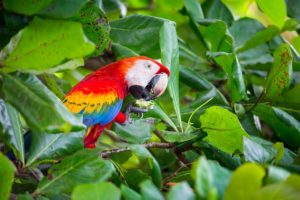Scarlet macaws, known as lapas in Costa Rica, are among the world’s largest and most colorful Neotropical parrots. Noted for its brilliant plumage and ear-piercing call, the scarlet macaw ranges from southern Mexico through Brazil and prefers humid, lowland rainforests such as those found in Corcovado National Park and sections of Carara National Park, on the outskirts of Jaco. Their presence hardly goes unnoticed, given their raucous screams and aerial acrobatics, which are a delight to behold on any Costa Rican vacation.
Click here and book your stay at one of our beautiful jungle villas!

Scarlet macaw sightings in Costa Rica
For avian enthusiasts, Carara and Corcovado National Parks are two prime spots for observing wild scarlet macaws in all their glory, though flocks are sometimes spotted up and down the Central Pacific coast. As their name implies, plumage is predominantly red, with accents of blue and bright gold on their flight and tail feathers. This species can measure up to 32 inches long and weigh just over two pounds. Unfortunately, the pet trade and habitat destruction in Costa Rica have reduced their range considerably over the past 100 years. They once inhabited rainforests all over the country, including the Caribbean slope, but are now contained in select pockets of jungle.
Macaw life and behavior
Most travelers to Costa Rica hear macaws long before seeing them against the verdant tropical backdrop. These migratory birds are notorious for their loud, guttural squawks that can resonate for miles. A few mating pairs or family groups can quickly morph into flocks totaling some 50 birds, which migrate above the forest canopy in search of food. Berries, seeds, flowers, nuts, fruit and leaves make up the majority of their diet, for which their sharp, pointed beaks are superbly adapted. It is also thought that due to a steady intake of clay, scarlet macaws can consume poisonous fruits that would be toxic to other creatures.
Nesting and mating in scarlet macaws

Lapas are entirely monogamous birds and always mate for life. They nest in vacated holes or cavities in tall deciduous trees where their brood can incubate and hatch in relative safety. Each year, a pair will lay one to four eggs and raise the young together. Carara National Park is a favored spot for observing nesting scarlet macaws in Costa Rica, thanks to its proximity to Jaco and Manuel Antonio. Highly intelligent and social birds, scarlet macaws can become very territorial during breeding season, and usually care for their young for at least two years.
Interesting facts
Being incredibly clever and beautiful has also been a curse for the scarlet macaw, spiking its demand in the pet industry. In the U.S., baby macaws can be sold for thousands of dollars, which only encourages illegal smuggling. Fortunately, conservation efforts in Costa Rica have ensured some level of protection for these magnificent birds, which are among the country’s most iconic wildlife. In captivity, a scarlet macaw may outlive its owner, though most wild species live between 40 and 50 years. Thanks to their powerful wings, flight speeds can top 35 miles per hour!
